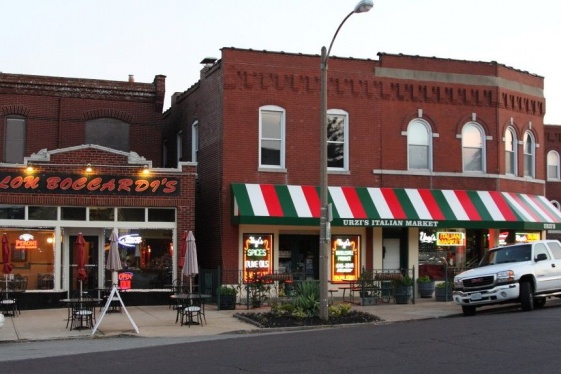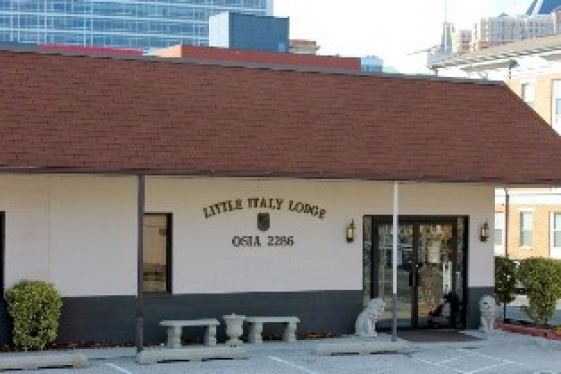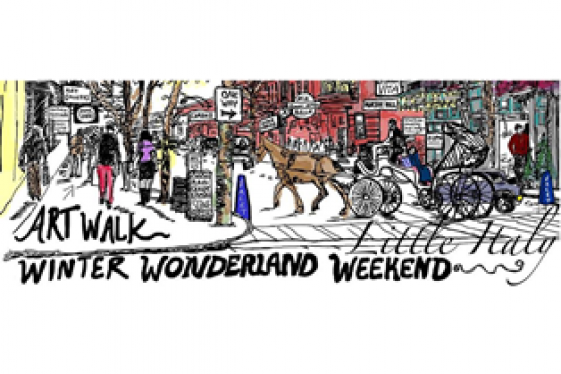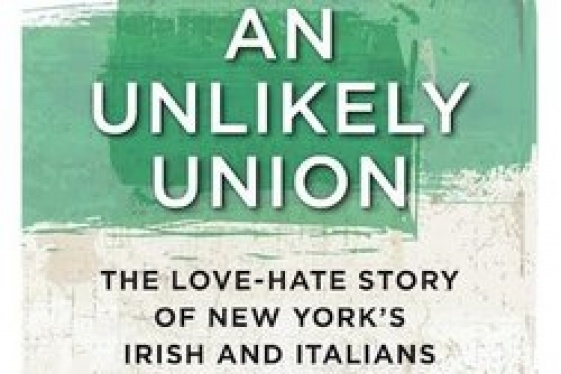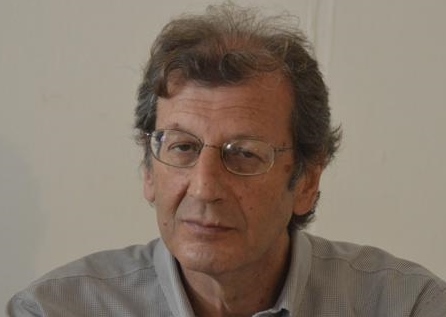
Francesco Durante (Professor of Italian American Literature)
La letteratura italoamericana, un tesoro da scoprire

Knowing the existence of a few books about the literary production of the Italians in America - from 1776 to World War II - written by a Neapolitan professor named Francesco Durante, we asked him to be interviewed, not knowing that thanks to him we would discover a world. An exceptional world, information very interesting and known by only a few, which highlight an important aspect of the Italian experience in the United States.
Talking to Francesco Durante, sole professor in Italy - at the University Suor Orsola Benincasa in Naples – of a course of Italian American studies, no doubt the one who knows more in Italy and probably in the world of literature of our countrymen in America, it was like meeting a living encyclopedia. An exciting experience, difficult to transfer to third parties: however we hope to be able to convey to our readers something of the fantastic journey into the literary production of the Italians in America conducted with him, to whom we send our heartfelt thanks. And to those who read, we really recommend to buy the new edition of his book Italoamericana , which will be published next year in the United States.
Professor Durante, you wrote some prestigious volumes describing a fundamental aspect of the Italian experience in America: the literature. Your work constitute an incredible illustration of the great italian emigration. Please tell us something about your books
I started to specialize in this subject thanks to John Fante. Elio Vittorini published him in the 40's, but he has been forgotten and rediscovered only later. I red "Ask the Dust" in the 80's and Mondadori asked me to translate "Dreams of Bunker Hill". Later I translated seven other John Fante's books: and in his work it's like if he gave voice to his father, a bricklayer native of Abruzzi who emigrated in United States. Fante is the typical narrator of the second generation: he's an eye witness of the family life of those who were between two worlds, often illiterate.
While I was reading Fante, I asked to myself: is it possible that we know about this first generation only through the stories of the next generation? So I began my research, that let me to discover a world of books and newspapers, songs and poetry, theater and political writings. Of course there were several writers who wrote in Italian for an Italian American audience. The material that I found was often extremely fragile, in a kind of paper so delicate to be handled with care: sometimes I was the last to consult some books or newspapers. I think I did a good job, but I have not finished yet: there is still a lot to discover, and many documents are very rare. For example, the "Diary of an immigrant" by Camillo Cianfarra, probably the rarest Italian-American book: there is only one copy of this book and it's located in Minneapolis, in the Immigration History Research Center, where I worked with Rudy Vecoli - the well known Italian American professor who founded this institution: it contains the most extraordinary part of the Italian American material of this kind, wich has often the same quality of the productions that at the beginning of the century had much success here in Italy. So I became the only chair in Italy of an Italian American course at the University Suor Orsola Benincasa in Naples, whom I donated my entire Italian American books library. There is much interest in this subject, I have a lot of students who go in the United Sates to continue their research.
I wrote two books about this topics, called "Italoamericana" and published by Mondadori: the first one (2001) is about the literature of the Italians emigrated in the Usa from 1776 to 1880; the second one (2005) concerns the period between 1880 and 1943. They're out of market now, but they had a good success in the past: they're a thousand pages each, so very expensive and thus reserved to a small niche. But recently, a publisher from Naples - Pironti – republished them in a new collection: "Italians History and Literature in the United States", with new updates found after the publication of Italoamericana. He divided the contents in ten smaller volumes to let the price being affordable: he just published the sixth volume (the first out, but the sixth in the collection), "La scena di Little Italy" ("The scene of Little Italy"), which is about theater, music and other happenings in the Little Italies. There's also another volume in Italian, ideally the third of Italoamericana, which is about documents written in the 30's and the 40's, called "Figli dei due mondi" (Sons of the two worlds").
In 2014, the Fordham University will publish in the United States the new version of the second volume of Italoamericana, the one that covers the years 1880-1943.
Please describe us a few interesting personalities that you discovered through your research
The most interesting person of the first generation is definitely Bernardino Ciambelli. He's a committed writer: when I started my research I found three books already known written by him, but after my research they became 25. He's extremely interesting to understand the New York of the late '800: Ciambelli does not only tell stories about Italian immigrants, but he also describes big buildings, undergrounds, the high line, the multi-ethnic neighborhoods. These are very strong plots: some of his novels are called "I misteri di Mulberry Street" ("The Mysteries of Mulberry Street"), "I drammi dell'emigrazione" ("The dramas of emigration"), "La trovatella di Bleecker Street" ("The foundling of Bleecker Street") and so on, and he describes the smokery halls in Chinatown, the Irish brothels, the tidy Jewish shops, and Little Italy. It's a wonderful metropolitan mosaic. Ciambelli was also a journalist: he died in New York in 1931 (the oldest of the Italian journalists at that time) while he was working for Luigi Barzini's "Corriere d' America" after being a very well known democratic political activist, and then turning to fascism. He published just in the US, but he studied in Italy before leaving. He probably studied in Naples (he is from Lucca) which was the capital of Italian journalism in the 80's of the XIX century.
Another great character was Riccardo Cordiferro, maybe the most famous poet of the heroic Little Italy in the Lower East Side. His real name was Alessandro Sisca and he came from Calabria. He was – among other things - the author of one of the most famous Neapolitan songs, Core 'ngrato, which is actually ... a New Yorker song, not a Neapolitan one. It is a typical emigration song, because it's written in 1911, but it's like if it was written in the 1880's: the operistic opening, the exasperated romance, the description of Italy as it was when the first generation of the great Italian emigration left, doomed in the imagination of the Italian Americans to remain always the same, the one they escaped from. Cordiferro has all the features of the first emigrants: he is a man forged with the idea of a post-revolutionary romanticism, of overwhelming love - a wife but many lovers, a defiant attitude on the political level (he goes to jail for a long time for his anarchist ideas which he will not change throughout his whole life). He also has a spectacular way to use words, having been a child prodigy: he founded "La follia di New York" ("The madness of New York") - a weekly magazine that lasted for a century - but he also directed the daily newspaper "La sedia elettrica" ("The electric chair") with a populist rhetoric a little adolescent and immature but full of feelings and passion. He therefore is the bearer of an "textbook" Italian identity with all the faults but also the virtues of the Italians as they were imagined then in America.
The third character I want to mention is Carlo Tresca, whom in the '30s Max Eastman dedicated a New Yorker cover with the title "Carlo Tresca, Public Enemy number one". He was then the most dangerous radical in America. He too is very Italian: a lot of charm, many lovers, all billionaires. Journalist, anarchist, he was killed after having participated in several strikes in defiance of the law enforcement and haranguing the crowds with great ardor. It is not clear who is responsible: maybe the Mafia, possibly on behalf of Gene Pope (the owner of the Progresso Italo-Americano, by Tresca accused of being a "gangster and a racketeer"), or maybe the fascists, or the Communists, namely the Stalinists against whom Tresca had published on the occasion of the harsh controversy over the civil war in Spain.
What are the themes that mainly recur in the literary production of the Italians in America? Is there something that changes over the years?
There is always an obvious autobiographical part. Before the great emigration, immigrants could reach the US only by sailing ships: it was a trip, "from the earth to the moon".
In the first volume of Italoamericana I tell about people who made seven times the tour of the world: exceptional resourcefulness and spirit of adventure, an elite emigration made for example of political refugees forming cells of Mazzini's Young Italy. They tell about themselves, they do engage in proselytism, it is much easier to integrate because they had high culture and they came from a land highly regarded in America. Many of the Founding Fathers knew the Italian language, and all the American iconography comes from the experience of ancient Rome, with the eagle and the Latin motto; besides, America has a strong sympathy for the renaissance wars. When Garibaldi arrived in New York in 1849 it was as if the most popular person in the world came into town: he is received with all the honors and refuses to stay in the luxury hotel indicated by the city, humbly preferring Meucci's house in Staten Island: this too adds consideration towards him. Then, this "falling in love" towards Italy drops significantly when the emigrants begin to come, bringing another kind of Italy.
But there is a continuity between the stories pre-1880 and the poorer and more dramatic ones of the great emigration. For example, Lorenzo Da Ponte is almost a prototype of the emigrant. He is a great poet in Vienna, with very high profile and reputation, who at 50 years (a very advanced age for that period), chased by creditors, goes to America. And there he has to invent a whole new life: as a revered poet he becomes a shopkeeper in Philadelphia, re-establishing its existence and only after he succeeds in being appointed director of an Italian school in New York and then the beginner of the exportation of classical music in America. So there is a path of an intellectual who starts to do manual labor - a very rare thing - and only after starts to do things most prestigious and less poor: anticipating the epic story of all those who laboriously climbed the social American ladder, or allowed that to their children, thanks to manual and very little intellectual jobs. The American social elevator allowed him to go back , something that could not have happened in Italy.
The themes of the emigration literature then become "How I built America": those who traveled feel legitimated to tell their stories, because they know they have done something important and courageous There's the memory of their distant country, but also the ability to describe the new world, particularly in the New York theater scene of the early twentieth century, such as in Eduardo Migliaccio - Farfariello in art - that having seen the Neapolitan "macchietta" in Naples has the great intuition to take it to New York, setting it there in the world of the Italian Americans, inventing characters like "ondertecco" (the undertaker), or "il cafone" (the peasant).
Another very important issue is women, or themes in which America is very different from Italy. There is no country in the world at that moment where women's rights are more ahead than in America. For example, in "The Mysteries of Mulberry Street" there is a paradox: the heart of the story is about an Italian woman married to a criminal, who fled to America. She emigrates to reach him, but when she comes to New York she realizes how much he is now despicable and compromised with the law. In the meantime, she falls in love with another man, but being married in Italy, where - unlike America – she cannot get a divorce, she cannot fulfill her love dream of love. In contrast, however, in America there is the death penalty, while not anymore in Italy: Ciambelli here describes how on one aspect a country is more progressive than the other, and how this situation completely changes on another topic.
Italians were discriminated, described as criminals and ignorant. They were "revenged" by some artists and athletes, who demonstrated that Italians were able to do something more than hand labors. Were there names in the field of literature that also made them proud of their origin?
No, there are no stars of this magnitude that appreciated also by the Americans, in the first generation, which, remember, writes in Italian. The performing arts are those that begin to give satisfaction with the second generation: indeed Italians Catholics read very few, their religion forbade that to them, unlike - to stay among the emigrants to America - the Jews, where everyone knows how to read and write, differently from the Italians. So among the Italians music and theater are the art forms more easily appreciated. The first author in chronological order that can be mentioned is Frank Capra, who wrote in Italian newspaper dedicated to our emigrants. A superstar is Rudolph Valentino, who publishes a book of poetry in English, but obviously cinema is why he was famous. The first real success came with Pascal D'Angelo, an immigrant who came from Sulmona where he was a pastor. Once he abandoned Abruzzi and his sheep, walking around with an English vocabulary in his pocket and forcing himself every night to learn some new words in his new language, in the mid 20's he won a national poetry contest and published a book in English called "Son of Italy". He died poor a little later, but at that moment he became a national case, the first to surge to general public attention.
Did the several Italian American newspapers have a big role in promoting these matters?
For the first generation, the Italian periodical press was fundamental. The novels of Bernardino Ciambelli, but also many poems and other documents, were published in the first instance in the newspapers, divided into episodes. It is a great source of information, unfortunately difficult to access because the collections are incomplete, as I said the paper is extremely fragile, and because it is not online nor digitalized; there is microfilmed material, but it is not complete and it is spread between various locations such as Minneapolis, Boston, New York, Florence and others. Besides, Italy has never bothered to exploit this literary production: on the contrary, it has always been said that great things made by the Italian Americans are only to be found in industry, manual things, but not in literature. Instead, compared to the Italian literary production of the time, which was built by intellectual elite enough away from everyday life, in these Italian American documents there is life, concrete and real: the suffering, the experiences of a dramatic and exciting phenomenon as the emigration. Snubbing them as has been done, considering them of little quality, it was not particularly wise.
Even from this point of view, the Little Italies had great importance ...
The Little Italies were on one hand a ghetto, because they allowed to keep on speaking Italian, or even the dialect, because there was no need to learn English; on the other hand, however, they were also the places of aggregation where the new Italy was getting created, where the emigrants were integrated with each other by turning from Calabrian or Sicilian or Neapolitan to Italians, before to become Americans.
If you had to name the most important Italian American writers of the twentieth century, what are the names that come to your mind?
Nowadays, probably the greatest American writer is of Italian descent, Don De Lillo. Richard Russo won the Pulitzer Prize a few years ago. Then I can't forget all the Italian names of the Beat Generation: Lawrence Ferlinghetti, Diane Di Prima, Gregory Corso. There is Philip Lamantia, there is Mario Puzo. And of course there's John Fante.
We believe that, here in Italy, the knowledge of the Italian experience in America over the decades unfortunately remains still marginal. Could their literature have a key role in this endevour?
There are really very few cases of publication in Italy of something from the Italian American writers of the first generation. One in particular, Paul Pallavicini, was published: he was a man from northern Italy who emigrated to California, in what was then known as the model colony, where the Italians were better integrated because they were not gathered and pressed-up in big cities, but many of them worked in agriculture or in the vineyards. Later, the second and third generations have often produced works that told the experience of the first generation. Think about Mario Puzo's "Mamma Lucia", a typical saga that starts from '800, or Helen Barolini's "Umbertina", also a saga about Italian American women, or "Streets of Gold" by Evan Hunter aka Ed McBain, the pseudonym of Salvatore Lombino, a native of Basilicata. Even Don DeLillo in "Underworld", though certainly not an ethnic narrator, speaks about the Italians in the Bronx. These second and third generations are responsible to tell these stories, finally published, both in America and in Italy.
Even cinema has done this: think about the Godfather saga. At the end of the '60s, an era full of antifamiliar claims, Puzo wrote a book in which the family is the center of everything. No matter if is a crime family, it however refers to an Italian epic that holds everything together and still manages to save this fundamental cell of society.
You may be interested
-
'Phantom Limb': A Conversation With Dennis...
Dennis Palumbo is a thriller writer and psychotherapist in private practice. He's the auth...
-
“The Hill” St. Louis’ Little Italy
When the fire hydrants begin to look like Italian flags with green, red and white stripes,...
-
1st Annual Little Italy Cannoli Tournament
Little Italy San Jose will be hosting a single elimination Cannoli tournament to coincide...
-
2015 scholarship competition
The La Famiglia Scholarship committee is pleased to announce the financial aid competition...
-
30th Annual Art Holiday Walk, Winter Winter...
Holiday walk hours Friday, 12/5 noon-9pm, Saturday ,12/6 noon-9pm Sunday, 12/7 noon-6pm. S...
-
An Unlikely Union: The love-hate story of Ne...
Award-winning author and Brooklynite Paul Moses is back with a historic yet dazzling sto...
-
Cathedral of St. John the Divine, Oratorio S...
For the first time ever, The Cathedral of St. John the Divine, in collaboration with the O...
-
Davide Gambino è il miglior "Young Italian F...
Si intitola Pietra Pesante, ed è il miglior giovane documentario italiano, a detta della N...






